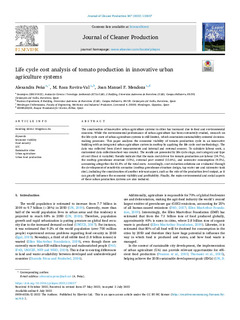| dc.rights.license | Attribution-NonCommercial 4.0 International | * |
| dc.contributor.author | Fernandez Mendoza, Joan Manuel | |
| dc.contributor.other | Peña, Alexandra | |
| dc.contributor.other | Rovira Val, María Rosa | |
| dc.date.accessioned | 2022-11-11T11:12:15Z | |
| dc.date.available | 2022-11-11T11:12:15Z | |
| dc.date.issued | 2022 | |
| dc.identifier.issn | 1879-1786 | en |
| dc.identifier.other | https://katalogoa.mondragon.edu/janium-bin/janium_login_opac.pl?find&ficha_no=168100 | en |
| dc.identifier.uri | https://hdl.handle.net/20.500.11984/5841 | |
| dc.description.abstract | The construction of innovative urban agriculture systems in cities has increased due to food and environmental concerns. While the environmental performance of urban agriculture has been extensively studied, research on the life cycle costs of urban agriculture systems is still limited, which constraints sustainability-oriented decision-making processes. This paper analyses the economic viability of tomato production cycle in an innovative building with an integrated urban agriculture system in rooftop by applying the life cycle cost methodology. The data was collected from direct measurements and internal and external sources. To calculate labour costs, a customised data collection sheet was created. The results are presented by life cycle stage, cost category and type of cost (fixed & variable). Results indicate that the main cost drivers for tomato production are labour (24.7%), the rooftop greenhouse structure (15%), external pest control (12.6%), and rainwater consumption (9.5%), accounting altogether for 61.8% of the total costs. Accordingly, cost reduction solutions are evaluated through the development of sensitivity scenarios (rooftop greenhouse structure design, tap water use and rainwater tank size), including the consideration of another relevant aspect, such as the role of the production level output, as it can greatly influence the economic viability and profitability. Finally, the main environmental and social aspects of these urban production systems are also included. | en |
| dc.description.sponsorship | Gobierno de España | es |
| dc.description.sponsorship | Comisión Europea | es |
| dc.language.iso | eng | en |
| dc.publisher | Elsevier | en |
| dc.rights | © 2022 The Authors | en |
| dc.rights.uri | http://creativecommons.org/licenses/by-nc/4.0/ | * |
| dc.subject | Economic viability | en |
| dc.subject | Food security | en |
| dc.subject | LCC | en |
| dc.subject | Sustainable cities | en |
| dc.subject | Urban agriculture | en |
| dc.subject | Urban food production | en |
| dc.title | Life cycle cost analysis of tomato production in innovative urban agriculture systems | es |
| dcterms.accessRights | http://purl.org/coar/access_right/c_abf2 | en |
| dcterms.source | Journal of Cleaner Production | en |
| local.contributor.group | Economía Circular y Sostenibilidad Industrial | es |
| local.description.peerreviewed | true | en |
| local.identifier.doi | https://doi.org/10.1016/j.jclepro.2022.133037 | en |
| local.relation.projectID | info:eu-repo/grantAgreement/GE/Programa Estatal de Investigación, Desarrollo e Innovación Orientada a los Retos de la Sociedad AEI/FEDER, UE. CTM2016-75772-C3-1-R/ES/Invernaderos integrados en azoteas: simbiosis de energía, agua y emisiones de co2 con el edificio ‐ Hacia la seguridad alimentaria urbana en una economía circular/Fertilecity II | en |
| local.relation.projectID | info:eu-repo/grantAgreement/EC/H2020/No 862663/EU/Food Systems in European Cities/FoodE | en |
| local.relation.projectID | info:eu-repo/grantAgreement/GE/Programa Unidades de Excelencia María de Maeztu/MDM-2015-0552/ES// | en |
| local.contributor.otherinstitution | https://ror.org/052g8jq94 | ca |
| local.contributor.otherinstitution | https://ror.org/01cc3fy72 | en |
| local.source.details | Vol. 367. Artículo 133037. September, 2022 | en |
| oaire.format.mimetype | application/pdf | |
| oaire.file | $DSPACE\assetstore | |
| oaire.resourceType | http://purl.org/coar/resource_type/c_6501 | en |
| oaire.version | http://purl.org/coar/version/c_970fb48d4fbd8a85 | en |








